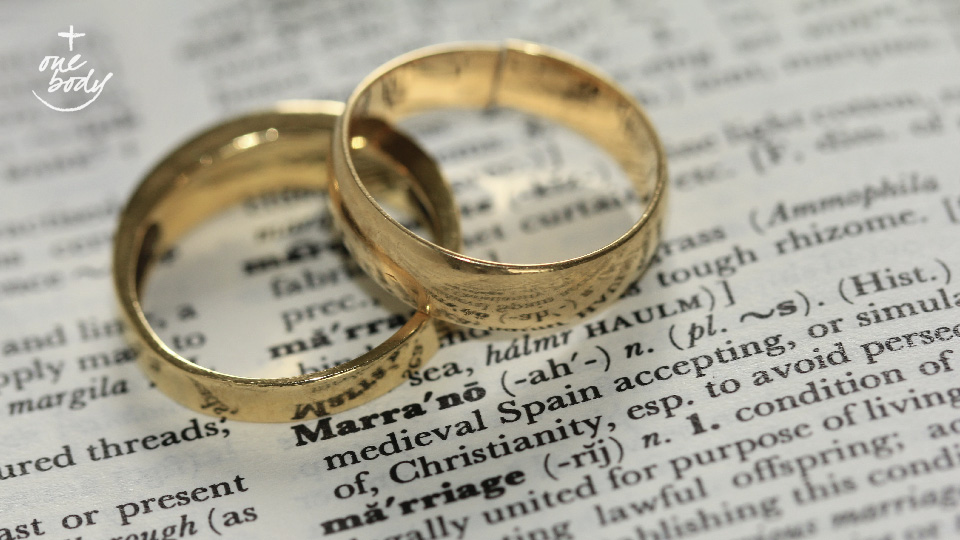

One in baptism and marriage: Interchurch families as a laboratory of unity | One Body
Nicholas Jesson
Thursday, April 28, 2022

Photo by Sandy Millar on Unsplash

One in baptism and marriage: Interchurch families as a laboratory of unity
by Nicholas Jesson
When I first encountered interchurch families in my early ecumenical work, I had no idea that I would eventually marry someone from another church and become an interchurch family. I am now married to the Rev. Amanda Currie, a Presbyterian minister. Yet, at the time, I had little experience with theological or pastoral questions of marriage and family and no clue about how these would be significant in ecumenical relations in Canada. Various surveys of Canadian dioceses since the 1980s have confirmed that 60% or more of marriages in Catholic parishes are what we used to call “mixed marriages”. This catch-all term includes marriages of a Catholic with anyone who is not Catholic, including other Christians, people of various other religions, and people with nominal or no religion. Most couples come to marriage with differing religious experiences or commitment levels, so most churches have historically cautioned against “inter-marriage” on practical grounds and sometimes with rather peculiar preconceptions about the other. Permission for mixed marriage? There is a persistent and false belief that the Catholic Church does not permit mixed marriages. This is simply not the case. It is true that until the late 1950s, Catholic canon law did not allow these marriages except “by necessity”. Until that time, mixed marriages would only be performed in the rectory, not in the church building itself. Family and friends were not permitted to be present, except for the required witnesses. As the rules changed, these marriages were moved to the sacristy and finally to the altar. Since the 1970s, though permission for a mixed marriage is still required, it is provided by the local bishop on the advice of the officiating priest or deacon that the particular circumstances do not indicate that the Catholic spouse will be encouraged to defect from the faith. These changes were enshrined in the 1983 Code of Canon Law, but they are applied somewhat unevenly depending on the ecumenical sensitivity of priests, bishops, and canon lawyers. The validity of marriage A peculiar Catholic prejudice about other Christians is that their marriages are not valid. Validity is a concept in Catholic theology and law regarding the sacraments that simply refers to the Catholic assurance that Christ is present in the sacrament. As some other Christians do not understand marriage as a sacrament, it is falsely assumed by some Catholics that these marriages cannot be valid. However, Catholic teaching holds that marriage between two baptized persons is a sacrament. The essential matter and form of marriage required for validity is the free and mutual consent of two baptized Christians entering into a lifelong monogamous commitment. Canon law also has concerns about the conduct of the wedding and various impediments which relate to “liceity” (the quality of being licit or lawful). While Canadian law also requires mutual consent and a lifelong commitment and prohibits marriage between close relatives, canon law has further requirements to ensure the dignity and solemnity of the occasion. The church ensures that the spouses are baptized, establishes the basic liturgy of marriage, requires marriage preparation, and provides other support to strengthen marriages. Thus, a Catholic is obligated to be married according to the form and liturgy of the Catholic Church and by a Catholic minister, although the local bishop may dispense from these. When a Catholic marries another baptized Christian, the bishop can give a “dispensation from the form of marriage” to permit the wedding in the other Christian community and by another Christian minister. Without a dispensation, such a marriage is “illicit” but not necessarily “invalid”. The promise Another persistent and false belief is that the non-Catholic spouse must become Catholic or at least agree that their children be baptized and educated in the Catholic faith. In some traditional Catholic countries, civil laws established these requirements, and the courts enforced them. However, the Catholic Church teaches that, as a matter of divine law, every baptized person has an obligation to pass on the faith to their children. This is the basic premise of the Catholic school system. It is why a priest, before marrying a Catholic in a mixed marriage, is to remind the person and their spouse that the Catholic has this obligation. However, Catholic ecumenical documents gently remind us that the other Christian in the marriage may have a similar obligation within their own church. This obligation is to be respected. A Catholic who fails to educate their children in the Catholic faith is not subject to any form of censure because the health of the marriage is our principal concern. Interchurch families An interchurch family is a marriage between two baptized Christians who each remain actively part of their own church and participate in their spouse’s church, at least occasionally. There is no single model for these families. Still, many of them establish patterns of church attendance that permit the family to worship together, perhaps alternating between their two churches week-by-week. Sometimes called “double belonging”, these couples frequently find themselves deeply immersed in both churches such that they find a home in each. In this way, they become ambassadors for their own tradition in their partner’s church, helping to build up understanding and love between congregations. Interchurch children frequently participate in religious education and other programs in both churches. Despite the widespread assumption that these children will be confused, most have little difficulty navigating the differences between the two church practices. One young boy from a Lutheran-Ukrainian Catholic family, upon being told by a grown-up that he must be confused, responded cheekily, “I’m not confused about whether I’m Lutheran or Catholic. I’m both. But, I’m confused about whether I’m Ukrainian or Norwegian.” In 1982, Pope John Paul II told interchurch families, “You live in your marriage the hopes and the difficulties of the path to Christian Unity.” He recognized that many of the challenges that these couples face in their churches result from the division between the churches. Though bound together in two sacraments, baptism and marriage, these couples are frequently divided at the altar because of the inability of their churches to heal the wounds of division. Their struggles in raising and educating their children within the church are frequently the result of navigating rules intended for a divided church, not a united family. Though interchurch families have frequently been cast as ecumenical or pastoral “problems”, they insist that they are an opportunity for the churches. Pope Benedict XVI described these families as “laboratories of unity”. Their ecumenical vocation is to explore and experiment, seeking ways to be a domestic church that already enjoys the unity that the churches are still seeking. They are a visible sign in our parishes of the unity given to us in Christ. The International Network of Interchurch Families has accepted this challenge, declaring, “We believe that, as interchurch families, we have a significant and unique contribution to make to our churches.” Interchurch families and synodality At a recent gathering of Canadian interchurch couples, the participants discussed whether there was a particular contribution that they could offer to the 2023 Synod of Bishops on synodality. The fundamental synod question is how the church has walked together in the local community. How have parishes, priests, and bishops “walked together” with these families? The first responses at this recent gathering described decades of neglect by pastors who had failed to welcome the gifts and ministry of these couples. After a lifetime of struggle in Catholic parishes, some couples recounted how they now find themselves primarily worshipping in their other church. Others described how their children had been made so unwelcome that they had given up on church altogether. Yet, through their stories of pain, the couples also recalled occasions of great support and connection in their parishes. Many of them spoke of pastors who had been advocates and friends. These pastors had walked together with them on their Emmaus road. When asked what they want to say to the Synod of Bishops, these couples identified both good and bad pastoral care as part of their experience. They spoke about how the church needs to learn to listen to the experience of couples struggling to give expression to the hope for Christian unity. And perhaps most importantly, they recognized that the church includes us all. Baptized in Christ, we are one people of God. The ecumenical vocation of interchurch couples is rooted in Christian baptism in which we are all bound together in Christ in a new creation, one pilgrim people, walking together as local church.Nicholas Jesson is the ecumenical officer for the Archdiocese of Regina, former ecumenical officer for the Diocese of Saskatoon, and former executive director of the Prairie Centre for Ecumenism. He is a member of the Roman Catholic-United Church of Canada Dialogue, editor of the Canadian Council of Churches’ Margaret O’Gara Ecumenical Dialogues Collection, and editor of the Anglican-Roman Catholic Dialogue archive IARCCUM.org.
Related Articles:
<<













